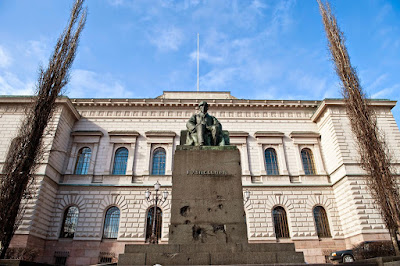Another example of tarot symbolism on statues is the J.V. Snellman statue in Helsinki, Finland. It was designed by Emil Wikström and unveiled in 1927.
The Helsinki Art Museum's introduction:
J.V. Snellman (1806-1881) was a philosopher, statesman, author and newspaperman. He designed a comprehensive plan for the development of the Finnish nation and of the state to be founded on it. He stressed the value of the Finnish language and the importance knowledge had in improving national self- awareness and action and as the precondition of a functioning state. He also finalized the monetary reform which gave Finland its own currency, the markka. Snellman's principal philosophical inspiration was Hegel, whose views he applied in his own works on government and philosophy. Snellman's memorial was commissioned from Emil Wikström. The funds were provided by a public collection.
Wikström designed a monumental and dignified sitting figure whose features were depicted in a realistic style. A plaster model was completed in 1915, but the as funds accumulated very slowly and a war was going on its casting was delayed. The work was finally unveiled in 1923. Architect Eliel Saarinen designed the statue's pedestal and surroundings.
 |
| J.V. Snellman statue |
 |
| J.V. Snellman statue in front of the Bank of Finland |
The designer, Emil Wikström, knew tarot symbolism very well. He is the same person who designed another tarot statue mentioned in this blog before, Elias Lönnrot memorial.
The esoteric level of this statue is revealed when you get the little joke about Snellman's history. For Finns, he was "the father of the Finnish markka" (currency before euro). Being autonomous part of the Russian empire, Finland got its own currency in the 1860's. Mr. Snellman (and his close ties to the Rothschilds) played the most important role in that process.
His statue stands in front of the Finnish central bank. He is depicted sitting on a chair, like a king on his throne. And he is considered "the father of the Finnish markka". Can you do the math?
 |
| (pentacles = coins) |
More examples of tarot statues on the page Esoteric statues.













































